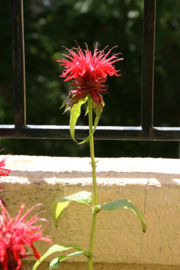Monarda: Difference between revisions
No edit summary |
No edit summary |
||
| Line 1: | Line 1: | ||
{{SPlantbox | |||
|genus=Monarda | |||
|Min ht metric=cm | |||
|Temp Metric=°F | |||
|jumpin=This is the plant information box - for information on light; water; zones; height; etc. If it is mostly empty you can help grow this page by clicking on the edit tab and filling in the blanks! | |||
|image=Upload.png | |||
|image_width=240 | |||
}} | |||
{{Inc| | |||
Monarda (after Nicolas Monardes, a Spanish physician and botanist, who published in 1571 a book containing accounts of American products. See Fig. 1850). Labiatae. Horse-mint. Annual and perennial, erect, aromatic herbs. | |||
Leaves dentate or serrate: calyx tubular, narrow, 15-nerved, nearly 5-toothed, mostly villous in the throat; fls. rather large, white, red, purplish, yellowish or mottled, in dense capitate clusters, mostly bracteate, terminal and sometimes axillary, the bracts often highly colored; corolla glabrous within, tube slightly dilated above; upper lip erect or arched; lower lip spreading, 3-lobed, the middle lobe larger or longer than the others; anther-bearing stamens 2, usually exserted, the posterior pair rudimentary or wanting; anthers linear; ovary 4-parted.—About 12 species, natives of N. Amer., including Mex. | |||
This includes the Oswego tea (M. didyma), one of the most brilliant of our native wild flowers, being surpassed in the intensity of its red only by the cardinal- flower. It is a rather coarse herb, with large heads of gaping, wide-mouthed flowers, which have none of the refinement of the cardinal-flower. For mass effects, however, these plants are very striking. They grow wild along the banks of streams, lighting up the dark corners of the woods. This suggests their proper place in landscape gardening. They should be grown in masses, in wild spots against a dark background. However, they can, if desired, be grown in an ordinary sunny border without more moisture than usual. As a bedding plant they would be inferior to Salvia coccinea, the flowers being shorter-lived. The white- and rose- colored varieties are less desirable. M. fistulosa is the same type of plant, and is procurable in colors ranging from white, flesh-color and lilac, through rose and crimson to deep purple, but not scarlet. This species is very variable in height. The lighter-colored varieties are usually less robust. | |||
Monardas are easy of culture, thriving in any good soil. They spread quickly, and therefore need frequent separation, which operation is best done in the spring, as plants disturbed in autumn will often winter-kill. | |||
}} | |||
__NOTOC__{{Plantbox | __NOTOC__{{Plantbox | ||
| name = ''Monarda'' | | name = ''Monarda'' | ||
Revision as of 11:42, 7 January 2010
| Monarda subsp. var. | ||||||||||||||||||||||||||||||||||||||||||||||||||||||||
|---|---|---|---|---|---|---|---|---|---|---|---|---|---|---|---|---|---|---|---|---|---|---|---|---|---|---|---|---|---|---|---|---|---|---|---|---|---|---|---|---|---|---|---|---|---|---|---|---|---|---|---|---|---|---|---|---|

|
|
| ||||||||||||||||||||||||||||||||||||||||||||||||||||||
| ||||||||||||||||||||||||||||||||||||||||||||||||||||||||
| Standard Cyclopedia of Horticulture |
|---|
|
Monarda (after Nicolas Monardes, a Spanish physician and botanist, who published in 1571 a book containing accounts of American products. See Fig. 1850). Labiatae. Horse-mint. Annual and perennial, erect, aromatic herbs. Leaves dentate or serrate: calyx tubular, narrow, 15-nerved, nearly 5-toothed, mostly villous in the throat; fls. rather large, white, red, purplish, yellowish or mottled, in dense capitate clusters, mostly bracteate, terminal and sometimes axillary, the bracts often highly colored; corolla glabrous within, tube slightly dilated above; upper lip erect or arched; lower lip spreading, 3-lobed, the middle lobe larger or longer than the others; anther-bearing stamens 2, usually exserted, the posterior pair rudimentary or wanting; anthers linear; ovary 4-parted.—About 12 species, natives of N. Amer., including Mex. This includes the Oswego tea (M. didyma), one of the most brilliant of our native wild flowers, being surpassed in the intensity of its red only by the cardinal- flower. It is a rather coarse herb, with large heads of gaping, wide-mouthed flowers, which have none of the refinement of the cardinal-flower. For mass effects, however, these plants are very striking. They grow wild along the banks of streams, lighting up the dark corners of the woods. This suggests their proper place in landscape gardening. They should be grown in masses, in wild spots against a dark background. However, they can, if desired, be grown in an ordinary sunny border without more moisture than usual. As a bedding plant they would be inferior to Salvia coccinea, the flowers being shorter-lived. The white- and rose- colored varieties are less desirable. M. fistulosa is the same type of plant, and is procurable in colors ranging from white, flesh-color and lilac, through rose and crimson to deep purple, but not scarlet. This species is very variable in height. The lighter-colored varieties are usually less robust. Monardas are easy of culture, thriving in any good soil. They spread quickly, and therefore need frequent separation, which operation is best done in the spring, as plants disturbed in autumn will often winter-kill.
|
Monarda {{{latin_name}}}
|
bee balm, oswego tea, horsemint
| ||||||||||||||||||||||||||||||||||||||||
|---|---|---|---|---|---|---|---|---|---|---|---|---|---|---|---|---|---|---|---|---|---|---|---|---|---|---|---|---|---|---|---|---|---|---|---|---|---|---|---|---|---|

|
|
| |||||||||||||||||||||||||||||||||||||||
| |||||||||||||||||||||||||||||||||||||||||
Monarda is a genus which includes Monarda didyma.
Cultivation
- Do you have cultivation info on this plant? Edit this section!
Propagation
- Do you have propagation info on this plant? Edit this section!
Pests and diseases
- Do you have pest and disease info on this plant? Edit this section!
Species
Gallery
If you have a photo of this plant, please upload it! Plus, there may be other photos available for you to add.
-
photo 1
-
photo 2
-
photo 3
References
- Standard Cyclopedia of Horticulture, by L. H. Bailey, MacMillan Co., 1963
External links
- w:Monarda. Some of the material on this page may be from Wikipedia, under the Creative Commons license.
- Monarda QR Code (Size 50, 100, 200, 500)
